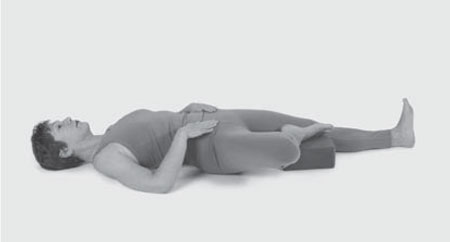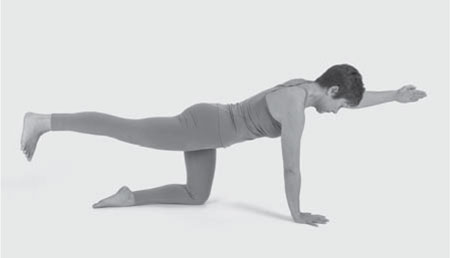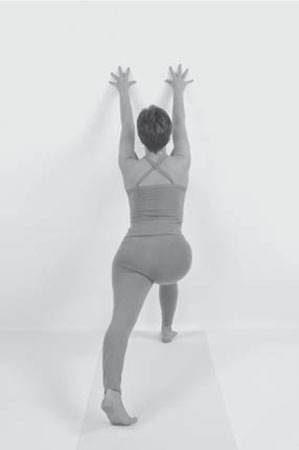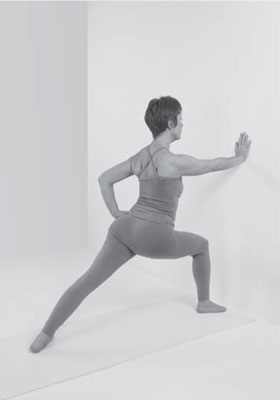Yoga for a Healthy Lower Back (20 page)
Read Yoga for a Healthy Lower Back Online
Authors: Liz Owen

FIG. 3.9
Variations: Supported Sacrum Release
Place a looped belt around the top of your right thigh at your front groin and raise your right leg into the base pose. Ask a partner to stand behind your right leg facing you, and to take the belt around the top of his right ankle or up along his calf, so that the belt is parallel to the floor. Hold your right foot with another belt, or have your partner hold your foot in place, raised toward the ceiling as it was in the original pose. Ask your partner to press his lower leg into the belt and step back, one small step at a time, as you stretch your leg up toward the ceiling and draw your foot toward your head. Feel your hamstring muscles releasing, and feel your sacral joints flat and grounded on the floor.
This partner assist relieves pain due to compressed sacral joints because it creates traction in the sacral joint on the lifted leg side, even more than when you do the pose yourself.
If you don't have a partner handy, you can do this variation on your own by using a long belt looped around your right front groin and your left foot as shown in
fig. 3.9
.
Hold Reclining Hand-to-Foot Pose and its variation for thirty to forty-five seconds on each side, then rest in
Happy Baby Pose
for a few moments.
Reclining Tree Pose
Balance and Strengthen | Supta Vrkshasana
Reclining Tree Pose helps the sacral joints come into balance. It is most helpful for a sacral joint that is rotated backward, because in the lying-down position, the action in your bent-leg hip will lift the joint upward and help it to come into balance with your other sacral joint. If your sacrum is already in balance, the pose helps brings stability to the joints. I've described it starting on the right side, but you can start on your left if you know that your left sacral joint is rotated backward. Regardless, it's well worth practicing this pose to both sides because of the firmness it brings into the whole sacral band.
Start by lying on your mat with your legs stretching straight away from your torso. Bend your right knee and bring your right foot to rest along your inner left thigh, supporting your outer right foot on a block so your hips stay even and balanced on the floor (
fig. 3.10
). Place your hands on your hip bones and balance your hips so they are an even distance from your waistline. Keeping your hips on the floor, lift your tailbone slightly upward and engage your abdominal core muscles. Now engage your right buttock muscles and feel your right hip lifting up toward the ceiling while your buttock stays grounded. This action helps lift the right sacral joint up to the level of your left sacral joint. Hold for ten seconds and relax. Repeat two more times to the right, then practice on the opposite side.

FIG. 3.10
When you are done, rest with your legs down on the floor or with your legs in
Reclining Knee Squeeze
and place your hands on your lower abdomen. Close your eyes and visualize your sacrum as the grand meeting place in your body through which energy now flows easily and with vitality.
Table-Balance Pose
Balance and Strengthen | Vyaghrasana Variation 1
Begin on all fours with your hands under your shoulders and your knees under your hips. Gaze down toward the floor. Keeping your spine in a neutral position, draw your navel toward your spine and draw your frontal hip bones toward your ribs to engage your abdominal core muscles. On an exhalation extend your right leg back and up until it is parallel to the floor. Press your right hand down and stretch up through your right arm, making it stable and strong. With your next exhalation, lift your left arm up and hold it parallel to the floor (
fig. 3.11
). Firm your deep hip muscles, draw your tailbone slightly down toward the floor, and keep your navel moving toward your spine.
Hold this position using the lift and strength of your abdominal core and your deep hip muscles. Remain for fifteen to twenty seconds, or come down as soon as you feel tired. Rest for a few moments in
Child's Pose
, and then repeat with the opposite arm and leg. Table-Balance Pose will help stabilize your sacral joints and strengthen your abdominal core, helping to bring your sacral joints into balance.

FIG. 3.11
Supported Deep Lunge Pose with Variations
Stretch and Strengthen | Virabhadrasana I Variations
Stand two to four inches away from a wall, facing it, and place your hands on the wall, slightly higher than waist height. Cup your hands so just your fingertips touch the wall. Bend your knees and as you exhale, take a big step backâfive feet if possibleâwith your left foot. Keep your left toes pointing straight forward, with your heel up in the air. If you feel unstable or vulnerable, place a folded blanket under your left heel for support.
Now drop your right hip and thigh toward the floor, bending your knee into a deep lunge. As your hip and thigh muscles open and strengthen with time and practice, your right hip will drop so your thigh is parallel to the floor. In every stage of descending your right hip down into a deep lunge, protect your knee joint by making sure your right knee is directly over your right ankle from side to side and front to back. Make sure your left leg stays straight and strong.
Take your left hand onto your sacral bone. Draw both thighs toward your hipsâyou should feel your sacral joints coming into balance. Just to make sure your hips are even with your sacral joints, draw your left hand around to your outer left hip and encourage it to press forward toward the wall. Support this action by rolling your left thigh inward. Now take your fingertips back to the wall to help support your torso in an upright position, seeing if you can maintain the sacral balance you've achieved.
Drop your tailbone down and scoop it toward the wall. Feel how this action creates lift all the way up through your torso and helps keep your lower back elongated. Exhale your navel back toward your spine and feel your abdominal wall supporting your torso. Stay here for a few breaths and see if your lower back is comfortable. If it is compressed or strained, lean your torso forward toward the wall until it releases.

FIG. 3.12
Feel your inner left leg elongating from your sit bone all the way to your inner heel, and lift the back of your left knee up toward the ceiling. Feel the length you are creating along the front of your left thigh as your quadriceps (front thigh muscles) and psoas (the muscle mainly responsible for creating neutral and upright hip position) stretch and elongate. Hold your pose for fifteen to twenty seconds and then come out by straightening your right leg and stepping your left leg forward to meet it. Come back to your starting position at the wall, and repeat the pose with your left leg forward and right leg back.
After you have done Supported Deep Lunge Pose to both sides, you can add two variations to your repertoire. When you have practiced this pose a number of times in complete comfort, you are ready to try
Proud Warrior Pose
in the “Grow and Progress” section of this chapter.
Variation 1: Sacral Broadener
Come into Supported Deep Lunge Pose with your right leg forward and your left leg back. Turn your left toes inward so they are facing slightly to the right, turning your left heel slightly out to the left. Reach through your left leg strongly from your sit bone to your heel, as if you were trying to ground your heel (your heel should not touch the floor, though). This foot position creates more internal rotation in the left hip joint, which in turn creates more stretch in your piriformis muscle and more broadness across your sacral band. Be sure not to drop your left hip down; hold your hips in as much balance as possible. Reach your arms as high up on the wall as possible (
fig. 3.12
). Hold this position for ten to twenty seconds. Then stand tall in Mountain Pose for a few moments, close your eyes, and experience the sensations in your left thigh and hip before repeating the pose to your opposite side.

FIG. 3.13
Variation 2: Grounding Lunge
Starting in Supported Deep Lunge Pose with your right leg forward and left leg back, turn your left toes slightly outward this time, so your left heel descends to the floor. Notice whether your left hip rotates backward when you place your heel down. If it does, mindfully reposition your left hip so it faces forward (
fig. 3.13
). Remember to drop your tailbone toward the floor to elongate your sacral joints and lumbar spine.
Keeping your spine as upright as possible and your head level, place your hands on the wall. Feel your body moving in two different directions at onceâthe base of your hips descends down toward the ground while the rest of your body lifts from your hip bones up through the crown of your head, creating an uplifting movement in your spine. Come out of the pose as before, and repeat with your left leg forward and your right leg back.
Protect Your Sacrum: Tips for Healthy Backbends
The next three poses are backbends that will strengthen your lower back and lengthen your psoas muscles. Earlier in this chapter, I described why backbends are good movements in a healthy sacrum, and now I want to teach you some specific actions that will help your body feel comfortable while you practice them.
If you have sacral issues, you may have been told backbends can help. Prone backbends including Cobra and Locust Poses are often the first yoga poses suggested by physical therapists for lower back pain. The theory behind the practice is clear and logicalâthose poses strengthen the buttock, hip, and lower back muscles, and elongate the psoas and front thigh muscles. All these actions contribute to your body's ability to carry its weight through your lower back and sacral joints. But if not practiced with care and support, back-bending movements can exacerbate back pain. You can experience the benefits of prone backbends
and
avoid discomfort by following a few “rules” for how to move your body in these poses. Keep the following in mind for the next three poses, and whenever you practice a backbend lying on your front body:
â¢Â  Ground your front body firmly from your feet up to your abdomen whenever your legs are positioned on the floor.